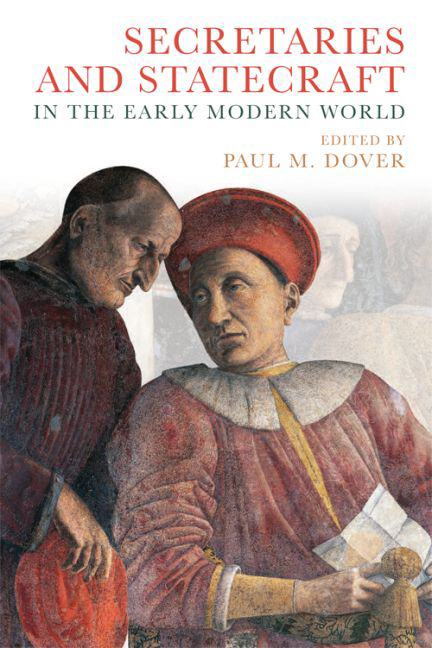Book contents
- Frontmatter
- Contents
- List of Contributors
- 1 Introduction: The Age of Secretaries
- 2 Records, Politics and Diplomacy: Secretaries and Chanceries in Renaissance Italy (1350–c. 1520)
- 3 Mercurino di Gattinara (1465–1530): Imperial Chancellor, Strategist of Empire
- 4 ‘This continuous writing’: The Paper Chancellery of Bernhard Cles
- 5 Parables and Dark Sentences: The Correspondence of Sir William Cecil and William Maitland (1559–73)
- 6 Axel Oxenstierna and Swedish Diplomacy in the Seventeenth Century
- 7 Statecraft and the Role of the Diplomat in Ducal Savoy: The Career of Alessandro Scaglia (1592–1641)
- 8 Richelieu, Mazarin and Italy (1635–59): Statesmanship in Context
- 9 The Learned Ideal of the Mughal Wazīr: The Life and Intellectual World of Prime Minister Afzal Khan Shirazi (d. 1639)
- 10 Reconsidering State and Constituency in Seventeenth-Century Safavid Iran: The Wax and Wane of the Munshi
- 11 Choreographers of Power: Grigorii Kotoshikhin, State Secretaries and the Muscovite Royal Wedding Ritual
- 12 Eberhard von Danckelman and Brandenburg's Foreign Policy (1688–97)
- 13 Chancellor of State: Prince Wenzel Anton Kaunitz, the Habsburg Foreign Office and Foreign Policy in the Era of Enlightened Absolutism
- Index
4 - ‘This continuous writing’: The Paper Chancellery of Bernhard Cles
Published online by Cambridge University Press: 21 November 2017
- Frontmatter
- Contents
- List of Contributors
- 1 Introduction: The Age of Secretaries
- 2 Records, Politics and Diplomacy: Secretaries and Chanceries in Renaissance Italy (1350–c. 1520)
- 3 Mercurino di Gattinara (1465–1530): Imperial Chancellor, Strategist of Empire
- 4 ‘This continuous writing’: The Paper Chancellery of Bernhard Cles
- 5 Parables and Dark Sentences: The Correspondence of Sir William Cecil and William Maitland (1559–73)
- 6 Axel Oxenstierna and Swedish Diplomacy in the Seventeenth Century
- 7 Statecraft and the Role of the Diplomat in Ducal Savoy: The Career of Alessandro Scaglia (1592–1641)
- 8 Richelieu, Mazarin and Italy (1635–59): Statesmanship in Context
- 9 The Learned Ideal of the Mughal Wazīr: The Life and Intellectual World of Prime Minister Afzal Khan Shirazi (d. 1639)
- 10 Reconsidering State and Constituency in Seventeenth-Century Safavid Iran: The Wax and Wane of the Munshi
- 11 Choreographers of Power: Grigorii Kotoshikhin, State Secretaries and the Muscovite Royal Wedding Ritual
- 12 Eberhard von Danckelman and Brandenburg's Foreign Policy (1688–97)
- 13 Chancellor of State: Prince Wenzel Anton Kaunitz, the Habsburg Foreign Office and Foreign Policy in the Era of Enlightened Absolutism
- Index
Summary
At the height of his political influence in 1531/2, Austrian Habsburg chancellor Bernhard Cles (1485–1539) commissioned artist Girolamo Romanino to paint his portrait in the newly constructed Audience Chamber of the Castello del Buonconsiglio in his prince-bishopric of Trent. The large lunette of Cles in his recently acquired scarlet cardinal's robes dominates the room's gold and black frescoes of the Habsburg dynasty he served: Austrian Archduke Ferdinand I speaking to his brother the Emperor Charles V, their father Philip the Fair and their grandfather Maximilian I. As Gesamtkunstwerk, the chamber celebrated Cles’ ‘exceptional credit and authority’ with both ruling Habsburg brothers. He was, in the words of a contemporary, ‘not only Bishop of Trent but also a temporal prince, and councillor and Grand Chancellor of all Germany, [enjoying] the greatest esteem and credit among all’. It is Cles’ office as statesman, advisor to the young Ferdinand, and above all chancellor which Girolamo Romanino's Portrait of Cardinal Bernhard Cles, 1531/32 particularly captures. Set in a shadowy bed-chamber, the portrait suggests Cles’ perpetual vigilance over the interests of the Casa d'Austria. Grave and calm, and with a packet of unopened letters in his left hand, Cles dictates to a soberly clad secretary, over whose epistolary production he casts an appraising gaze.
Cles’ biographers have highlighted his pivotal role as princely advisor during a critical decade in European history, from 1526 to 1539. Due to his frequent absences from court, however, they have questioned the degree to which Cles was engaged in chancellery affairs and foreign policy-making on a daily basis. A rich and growing body of literature on court culture has emphasised how imperative it was for early modern courtiers to remain in close physical proximity to the prince, should they wish to retain favour, access and ultimately influence, authority or reward. Although often absent from court, Cles’ influence with his sovereign did not wane, and he did not eschew political engagement. Nor did his absences necessarily entail political crises or administrative delay; in Cles’ case, distance does not appear to have been Fernand Braudel's ‘public enemy number one’ of sixteenth-century statecraft. Instead, as this chapter argues, Cles’ protracted absences meant that his was a paper-borne foreign policy-making apparatus and a chancellorship exercised by correspondence.
- Type
- Chapter
- Information
- Secretaries and Statecraft in the Early Modern World , pp. 63 - 89Publisher: Edinburgh University PressPrint publication year: 2016

